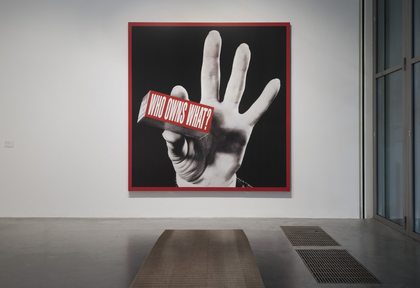Who owns what? uses the methods of mass media and advertising to question consumerism
This room brings together an artwork by Barbara Kruger with resources produced by Tate to explore how contemporary art has responded to the rise of the mass media and digital technology.
Early in her career, Kruger worked as a graphic designer and her work shows a close understanding of the dynamic visual language of advertising. Yet its content is often highly confrontational, challenging the viewer to question the culture of consumerism.
The accompanying resource brings together quotations from artists and other thinkers about the impact of the mass media and digital technology on the way we make and look at art.
When you share an image, is it still yours? Share and display your thoughts about creativity, communication and ownership. #TateNetworks
Barbara Kruger Who Owns What? 2012
Kruger’s images grab the viewer’s attention with an approach that is instantly recognisable, using found photographs that are cropped, manipulated and printed in monochrome, and overlaid with text enclosed in a block of red.
Early in her career Kruger worked as a graphic designer and picture editor for glossy magazines such as Mademoiselle and House & Garden. When she came to prominence as an artist in the 1980s, her dynamic visual style seemed intertwined with the highly sophisticated advertising techniques of that period. However, her work consistently questions the assumptions that underlie the culture of consumerism. Directly addressing the viewer, Kruger’s texts are often ironic, accusatory or confrontational, challenging us to think about social inequality, gender politics and the false promises of capitalism. In Who owns what?, a hand holds up an object for our inspection, as if showing off a dazzling trinket, or offering it for sale.
The brevity of the text highlights the wide-ranging complexity of the question that it poses, which can be interpreted and answered in many ways. As statistics reveal that wealth is concentrated in ever fewer hands, with the richest 1% owning as much as the remaining 99% combined, Kruger’s work remains powerfully relevant.
Curated by Matthew Gale

